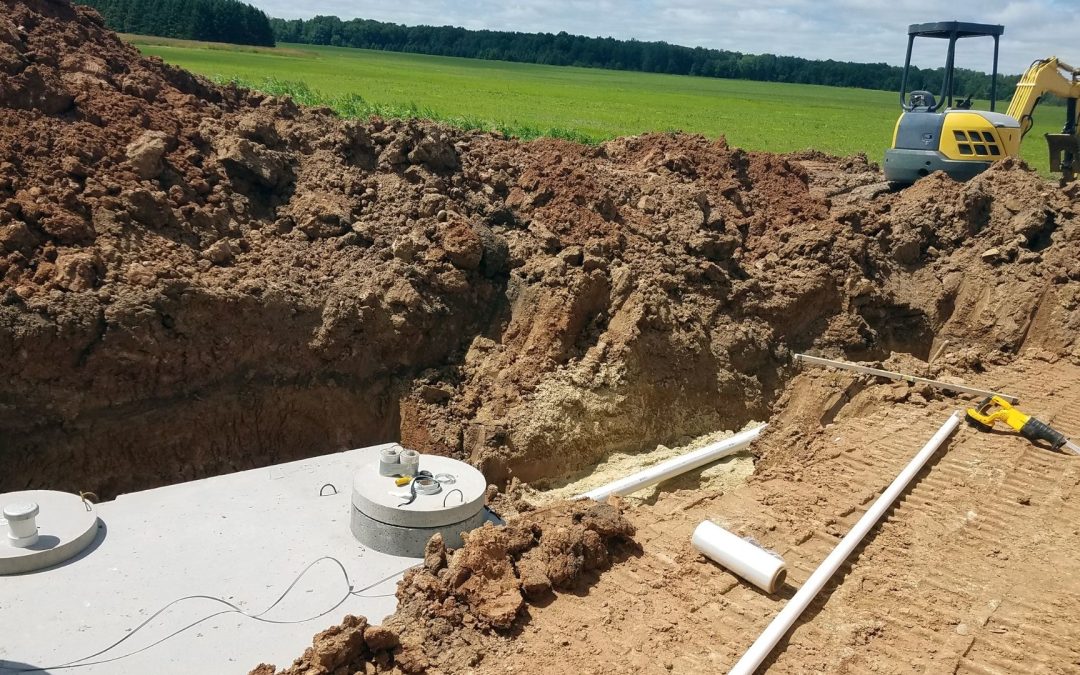A septic system is built into the house to treat wastewater from showers, toilets, sinks, washing machines, dishwashers and the like before releasing it into the ground. It is usually made up of two main parts – a septic tank and a leach bed (also called a drainage field). The septic tank is a watertight box that’s usually made of concrete, fibreglass, or polyethylene. It collects all the wastewater from the home and separates the solids from the liquids. The solids settle to the bottom, forming a ‘sludge,’ while the oils and grease float to the top as ‘scum.’
The liquid effluent then exits the tank and flows into the leach bed, also known as the drainage field. This is a dispersal system constructed using perforated pipes that are buried in gravel-filled trenches or a covered bed. The effluent seeps out through the holes in the pipes and drains into the soil below. Here, natural anaerobic bacteria in the soil provide the final treatment by digesting residual organic matter and waste through a biological recycling process before it percolates down into the local groundwater table.
The costs associated with installing a septic system can vary significantly depending on the size needed for the home, soil and site conditions, local regulations, along unforeseen challenges that may arise. As a town located in central Ontario along the shoreline of Georgian Bay, septic system costs in Parry Sound tend to be influenced by the geology and composition of the area’s soil types near the surface. This article will provide homeowners with a breakdown of typical expenses to expect when installing and maintaining a septic system in Parry Sound.
Soil Conditions in Parry Sound
Understanding the local soil is important for determining proper septic system design and costs. Much of Parry Sound contains glacial till soils, characterized as rocky mixtures of sand, silt, and clay deposited by retreating glaciers. Depth to bedrock is highly variable, ranging from a few inches to over 6 feet below ground, depending on location. The irregular bedrock surface makes the complete examination of soil profiles challenging. Soils also exhibit imperfect drainage due to stratification and change dramatically over short distances.
These conditions require more robust septic systems in Parry Sound compared to loose, porous soils with greater depths to bedrock. Deeper trenches or beds are often needed to obtain sufficient soil treatment area. Irregular bedrock may restrict system placement or require pre-treatment to reduce wastewater strength before dispersal. These factors all drive up installation costs compared to simpler designs on flatter, uniform soil types. A basic soil analysis testing permeability and structure is essential to guide the appropriate septic solution and a smooth septic system installation for a Parry Sound property.
Initial Cost Considerations
The first essential component of a septic system is the septic tank. Prices vary depending on the storage capacity required based on the number of bedrooms and daily water usage volumes projected for the home. Tanks range in price depending on material and capacity.
Once soil testing is complete, the size, type and layout of the required leach bed or field is determined. Basic leaching systems utilize perforated pipes laid in gravel-filled trenches. More advanced designs may employ elevated sand mounds, chamber systems, or other specialized elements suitable for Parry Sound’s geological conditions.
Installation Expenses
Bringing a septic system from the design phase to full operation on the ground involves additional labour costs. Factors such as access, weather, amount of excavation required, and unforeseen obstacles all influence installation pricing. In Parry Sound, it’s common to encounter bedrock and boulders just below the surface. As a result, property owners should budget solely for excavation and site preparation, depending on the difficulty level. Bringing in required equipment for difficult jobs drives costs upward.
Additional Post-Installation Expenses
Landscaping and site restoration following the initial installation ensure proper drainage and aesthetics. Restoration produces a balanced finished grade while reseeding grass or replanting bushes and shrubs removed during the process. These completions vary in price depending on the work area size and any repairs required to the existing landscaping or structures.
An inspection by provincial health authorities before putting the new system into service adds to the price to verify that everything meets regulations. Homeowners discover necessary repairs during this approval stage approximately 10-15% of the time, introducing additional unforeseen costs until full compliance is achieved.
Operation and Maintenance Costs
Beyond installation, septic systems demand periodic maintenance to safeguard the investment and protect local water resources. Foremost is pumping out the septic tank every 3-5 years through a licensed maintenance contractor.
Occasional repairs addressing items like corroded pipes, cracked or settling tanks, or clogged leach bed filter fabric also vary in cost depending on the specific needs. Home improvements like bath or laundry room additions promote extra water use, shortening system life unless appropriately designed from the start.
Savvy homeowners proactively monitor electrical and water use, limit toxins entering their tanks, and avoid heavy equipment or structures over the drainage area. These best practices can double a system’s functionality for decades of household wastewater management.
Overall Cost Estimates
At the moment, the average cost to install a regular-sized class 4F filter bed septic system in Sequin, Ontario, ranges between $22,000-$28,000. However, factors including house size, specialized componentry, difficult soil situations, or future improvements may warrant higher investment.
Obtaining competitive quotes from three experienced local contractors customized for each property site provides the most accurate pricing. Unforeseen complications during excavation occasionally demand budget contingencies. Overall system lifespan and functionality rely upon following maintenance guidelines tailored by designers.
Conclusion
Relying on septic systems as a standard method of on-site wastewater treatment represents a long-term commitment requiring both financial resources and diligent property owner stewardship for Parry Sound homeowners to protect their investment and the shared water resources. While varying costs occur between projects, these estimates furnish a general framework for budget preparation.
Consulting qualified septic professionals from the project start guides selecting appropriately designed, installed and maintained solutions for a household’s specific setting and usage requirements. Which is where we come in.

